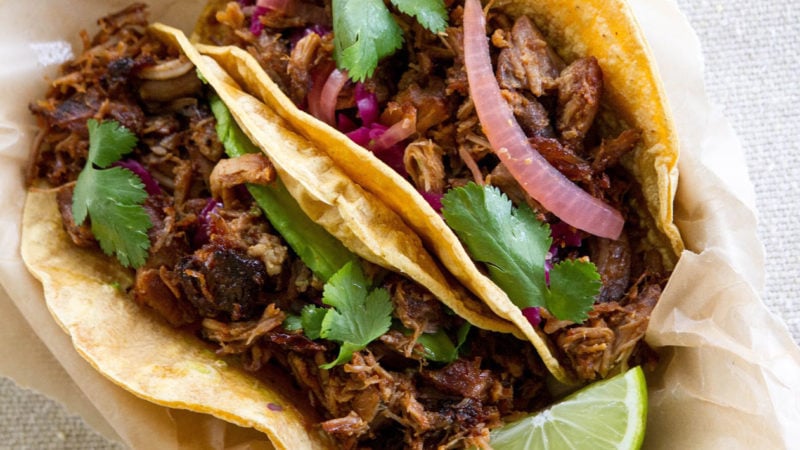Last Updated on October 6, 2021
Tacos are everywhere.
Not only are there a lot of traditional Mexican and Tex-Mex restaurants concocting tacos with fantastic flavor combinations or perfecting the classic Mexican street taco, but there are also a plethora of amazingly delectable taco recipes that are quick and easy-to-make at home.
How tacos evolved from Mexican laborers’ food to an almost ubiquitous item on American restaurant menus and a global phenomenon involves colonialism and cultural appropriation, as well as cultural appreciation through food and the fusion of foodways. It is a tale that combines the innovation of the indigenous peoples of the central regions of the Americas, the Spanish and North African influences on Mexican cuisine, and the competing and continual integration of authentic Mexican cooking and American fast-food culture.
Food Innovation to Silver Mines
According to Jeffrey M. Pilcher, professor of history at the University of Minnesota and the author of the book Planet Taco: A Global History of Mexican Food, the origins of the modern taco can be traced back to the various indigenous groups who built civilizations thousands of years ago in what is now Mexico. They developed a process—still in use today—called nixtamalization which uses a warm alkaline solution to transform corn in a number of ways chemically making it more appetizing and nutritious.
Pilcher explains in his book that, “People have been eating corn tortillas with bits of meat or beans rolled up inside for more than a millennium.” These corn-dough snack foods were known as antojitos and would come in many shapes with a variety of fillings.
As Pilcher believes, tacos can be traced to the snacking habits of Mexican silver miners.
The Spanish word taco was used for a “small bite of food” well before it can be found used in Mexico, according to Taco Planet. The term was used in a number of different ways originally including to signify dowels or cloth firearm plugs, among other things.
At one point, “taco” was slang for gunpowder wrapped in paper used by silver miners outside of the town of Pachuca. It happened that these Mexican miners also preferred rolled tacos — and used that same term for both explosives and their packable lunches. Once the silver mining operations died down, they brought their rolled version of the dish to the streets of Mexico City, and then later to the American Southwest.
Tex-Mex and the Fast Food Taco
The taco typifies Mexican food culture in a couple of ways. First, there are innumerable varieties of the food, which reflect the wide range of differences among a large number of distinct regional food traditions of Mexico. Second, tacos represent just how fine line it can be between cultural appropriation and cultural appreciation as it comes to food.
Mexican Americans living in the “borderlands” created various versions of tacos influenced by the mixing of cultures along the US-Mexico line. Tex-Mex, New Mexican, and Cal-Mex cuisines all had their own versions of the taco. Rolled tacos, for instance, are still popular at Mexican restaurants in Southern California today.
Tex-Mex is the style that has been most commonly copied throughout the United States. This foodway arose out of the Rio Grande Valley, the area closest to the Mexican border in Texas.
While at a rolled taco shop in California in the 1960’s when hot dog vendor Glenn Bell realized he could quicken the pace of the methods used to make the long-cooking, fried rolled tacos. He realized he could do for the taco what McDonald’s did for the cheeseburger and opened his first taco shop in San Bernadino. Taking a relatively little-used preparation technique — the pre-fried, U-shaped, crispy corn tortilla shells — Bell’s restaurant, which eventually became Taco Bell, turned a Mexican food tradition into an American staple.
But Taco Bell has also become a prime example of how the cultural appropriation of food can exploit power differences between peoples and foodways.
Appreciating Taco Traditions
It is not hard to imagine why, but there has been a large food culture backlash against Glenn Bell’s crispy version among taco and food aficionados.
The days, the standard Mexican street taco—or at least versions of it, including those made with barbacoa or carnitas, and a garnish of onions and cilantro—is prevalent everywhere from authentic Mexican restaurants and hole-in-the-wall Mom-and-Pop joints to high-end restaurants and street vendors to food trucks and the like. And yet, there is still a whole, wide-ranging world of tacos to explore, journey to, and create at home.
In his book on tacos, Jeffrey Pilcher made a trek to Hermosillo, Mexico, to try the region’s hard-to-find, traditional taco specialty, carne asada tacos. To make a point about “fast food,” he recounts the two minutes it took the husband and wife street cart vendors to grill their steak to perfection and fill it in warm tortillas with onions and cilantro.
On his return to America, he compares his experience in Hermosillo with the two minutes it took the staff at a Los Angeles Taco Bell to nuke their take on the steak taco.
You don’t have to go to Hermosillo to appreciate and enjoy a great taco; which is the best thing about tacos when it comes down to it: How easily you can enjoy them at home.
Dennis Keohane is a writer, editor, and former Editorial Director for ButcherBox with a passion for storytelling and food. Combining his love for high-quality ingredients with engaging narratives, he crafts content that inspires home cooks to explore new flavors, techniques, and the joy of cooking.



